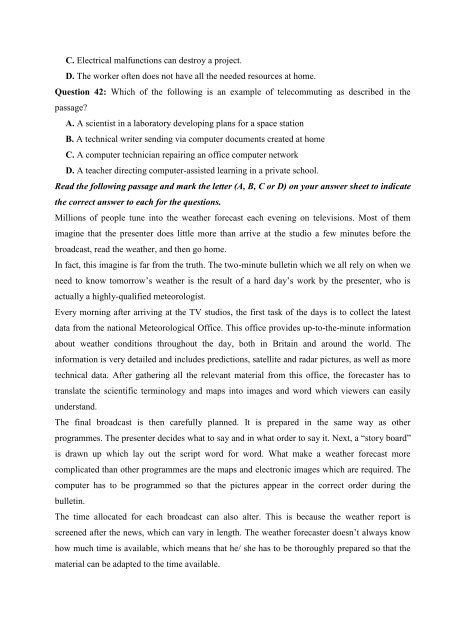Bộ đề thi thử THPTQG năm 2018 - Môn Tiếng Anh - 20 ĐỀ + ĐÁP ÁN - GV Kiều Thị Thắng - Tuyensinh247
https://app.box.com/s/fdml0d4t6lk8t30qzh0xow50qpjgs63c
https://app.box.com/s/fdml0d4t6lk8t30qzh0xow50qpjgs63c
You also want an ePaper? Increase the reach of your titles
YUMPU automatically turns print PDFs into web optimized ePapers that Google loves.
C. Electrical malfunctions can destroy a project.<br />
D. The worker often does not have all the needed resources at home.<br />
Question 42: Which of the following is an example of telecommuting as described in the<br />
passage?<br />
A. A scientist in a laboratory developing plans for a space station<br />
B. A technical writer sending via computer documents created at home<br />
C. A computer technician repairing an office computer network<br />
D. A teacher directing computer-assisted learning in a private school.<br />
Read the following passage and mark the letter (A, B, C or D) on your answer sheet to indicate<br />
the correct answer to each for the questions.<br />
Millions of people tune into the weather forecast each evening on televisions. Most of them<br />
imagine that the presenter does little more than arrive at the studio a few minutes before the<br />
broadcast, read the weather, and then go home.<br />
In fact, <strong>thi</strong>s imagine is far from the truth. The two-minute bulletin which we all rely on when we<br />
need to know tomorrow’s weather is the result of a hard day’s work by the presenter, who is<br />
actually a highly-qualified meteorologist.<br />
Every morning after arriving at the TV studios, the first task of the days is to collect the latest<br />
data from the national Meteorological Office. This office provides up-to-the-minute information<br />
about weather conditions throughout the day, both in Britain and around the world. The<br />
information is very detailed and includes predictions, satellite and radar pictures, as well as more<br />
technical data. After gathering all the relevant material from <strong>thi</strong>s office, the forecaster has to<br />
translate the scientific terminology and maps into images and word which viewers can easily<br />
understand.<br />
The final broadcast is then carefully planned. It is prepared in the same way as other<br />
programmes. The presenter decides what to say and in what order to say it. Next, a “story board”<br />
is drawn up which lay out the script word for word. What make a weather forecast more<br />
complicated than other programmes are the maps and electronic images which are required. The<br />
computer has to be programmed so that the pictures appear in the correct order during the<br />
bulletin.<br />
The time allocated for each broadcast can also alter. This is because the weather report is<br />
screened after the news, which can vary in length. The weather forecaster doesn’t always know<br />
how much time is available, which means that he/ she has to be thoroughly prepared so that the<br />
material can be adapted to the time available.


















